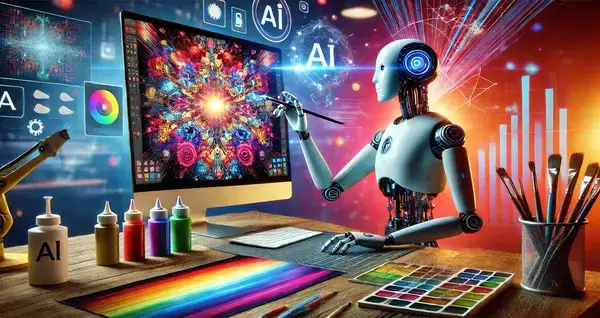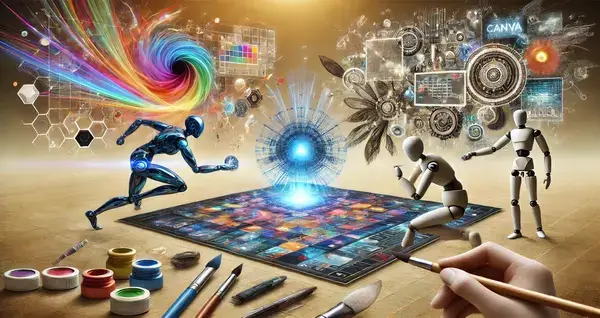EMAIL AT- support@itldigitaltech.com CALL AT- +8801830312344

Artificial intelligence (AI) is revolutionizing photo editing by automating complex tasks and increasing creativity. Platforms like Canva are incorporating AI features, such as Stable Diffusion powered by Magic Edit, enabling users to effortlessly transform images. (canva.com)
Despite these advances, AI is not replacing traditional photo editing tools but rather complementing them. AI-powered features streamline workflows, allowing designers to focus on the creative aspects while maintaining control over the final output. This combination increases efficiency without compromising the unique touch that human creativity brings to design.
In conclusion, AI is reshaping the photo editing industry by augmenting existing tools and empowering users to achieve professional results more easily. The collaboration between AI capabilities and traditional editing platforms is paving the way for a more efficient and creative future in design.
Artificial intelligence (AI) is reshaping various industries, and the world of design and photo editing is no exception. With the ability to create, modify, and enhance images with minimal human input, AI is often seen as a potential replacement for traditional photo editing tools like Canva, Photoshop, and others. But is AI replacing these tools, or is it simply augmenting their capabilities? Let’s explore.
Table of Contents
The Rise of AI in Photo Editing
AI has significantly improved image creation and editing. From automatic background removal to intelligent photo enhancement, AI-powered tools offer:
Speed and efficiency: Tasks that used to take hours, such as complex edits or design adjustments, can now be completed in seconds.
Accessibility: AI tools like DALL-E and Runway make advanced design capabilities available to non-experts.
Personalization: AI algorithms can analyze user preferences to increase creativity and productivity, creating tailored designs and edits.
These innovations have raised questions in many minds about whether AI can fully replace tools like Canva.

AI vs. Traditional Tools Like Canva
While AI offers revolutionary features, tools like Canva remain popular due to their simplicity and versatility. Let’s compare:
Ease of Use:
Canva offers an intuitive drag-and-drop interface that allows users to create professional designs with minimal effort.
AI tools, while powerful, can require a learning curve to understand the prompts or effectively modify the results.
Customization:
Canva offers extensive templates, fonts, and design elements, giving users a sense of control.
AI often creates content autonomously, which may not always align with the user’s exact vision.
Cost:
Canva offers free and affordable premium plans, while some AI tools can be expensive due to their advanced capabilities and computational requirements.
Human creativity:
Canva encourages hands-on design, enabling users to explore their creativity.
AI can sometimes limit creativity by providing overly automated solutions.
Complementary, not competitive:
Rather than replacing Canva and other tools, AI is more likely to complement them. Many platforms are already integrating AI features:
Canva uses AI for tools like Magic Resize and Background Remover, making it more efficient for users.
Adobe Photoshop’s AI features, such as Neural Filters and Content-Aware Fill, enhance traditional photo editing workflows.
This integration creates a hybrid model where AI enhances the user experience rather than eliminating the need for traditional platforms.
Challenges for AI in Tool Replacement
While AI is powerful, there are challenges to consider:
Quality control: AI-generated designs may require human intervention to ensure accuracy and relevance.
Ethical concerns: Using AI in creative work raises questions about originality and copyright.
User adoption: Not all users are ready to embrace AI-powered workflows, especially those who value manual control and craftsmanship.
The future of photo editing with AI
AI is not replacing Canva or other tools but is changing the way we approach photo editing and design. The future likely lies in the integration of AI capabilities into traditional tools, creating a seamless experience for users.
As AI continues to evolve, platforms like Canva will adapt by incorporating advanced AI features while maintaining user-friendly interfaces. This combination will empower users with both creative freedom and cutting-edge technology.
The future of AI in image creation is promising and transformative, with advances expected to significantly impact the creative arts, communications, and technology. Here are the key trends and prospects:
1. Advanced creative tools
Generative art: AI will enable artists and creators to effortlessly create unique and highly detailed works of art. Tools like generative adversarial networks (GANs) and diffusion models will continue to improve, producing images that are indistinguishable from human-created art.
Collaboration: AI will act as a co-creator, assisting artists by providing suggestions, completing sketches, or transforming ideas into visuals.
2. Real-time image generation
Interactive media: AI-powered tools will allow users to create images in real time, making them integral to video games, virtual reality (VR), and augmented reality (AR).
Personalized content: Applications like marketing and entertainment will use AI to create custom-tailored visuals for individual audiences.
3. Photorealism
AI systems will advance the creation of photorealistic images, which can mimic real-world environments for applications in cinema, advertising, and simulation.
4. Democratization of image creation
Accessibility: AI will lower the barrier to entry in creating professional-quality images, allowing non-experts to create complex visuals with minimal effort.
Affordable production: Small businesses and individuals will have access to tools that were previously cost-prohibitive.
5. Increased productivity
Automation: AI can automate repetitive tasks like background removal, object identification, and image resizing, freeing up creative professionals for more complex work.
Batch creation: Creating multiple variations of an image or a series of sequential visuals will become more efficient.
6. Ethical and regulatory challenges
Deepfakes and misinformation: AI-generated images can be used to spread false information, requiring strong verification mechanisms.
Copyright and Ownership: Legal frameworks need to be developed to address questions about ownership and use of AI-generated images.
7. Integration with other technologies
AR/VR: AI-generated visuals will enhance immersive experiences in AR and VR, offering hyper-realistic environments or artistically crafted spaces.
3D modeling: AI will help create 3D models from 2D images, revolutionizing industries such as gaming, architecture, and design.
8. Sustainability
AI tools can optimize resource use in industries such as advertising and entertainment by reducing the need for physical setups, saving time, materials, and energy.
9. Cultural impact
Redefining art: The line between traditional art and digital creation will blur, sparking debates about the definition of creativity and the role of humans in art.
Global Impact: AI will bring diverse cultural aesthetics to image-making, fostering a rich global exchange of ideas.
10. Future Prospects
AI Image-to-Image Translation: Tools that allow for transformation between styles, mediums, and contexts will expand creative possibilities.
Adaptive AI Models: Future models can learn personal preferences and tailor their output to specific user needs.
AI’s role in image-making is set to grow as technological advances combine with human creativity to unlock new dimensions of visual expression.
Conclusion
AI is undoubtedly a game-changer in photo editing, but it is not a replacement for tools like Canva. Instead, it complements and enhances these platforms, making design more accessible and efficient. By embracing the power of both AI and traditional tools, creators can unlock new possibilities in the world of design.
